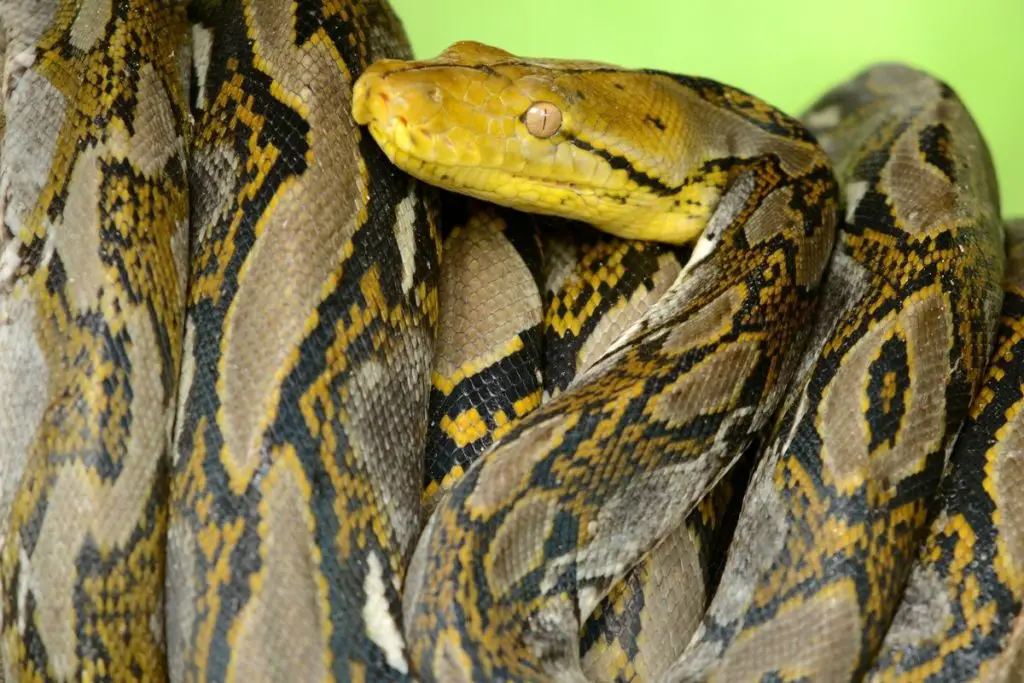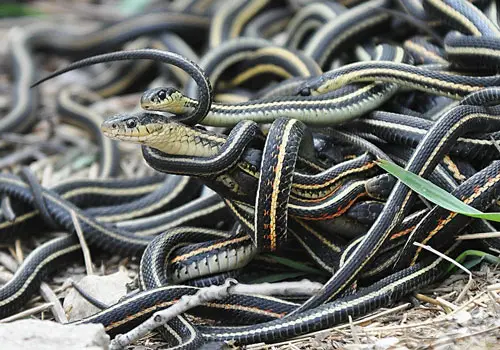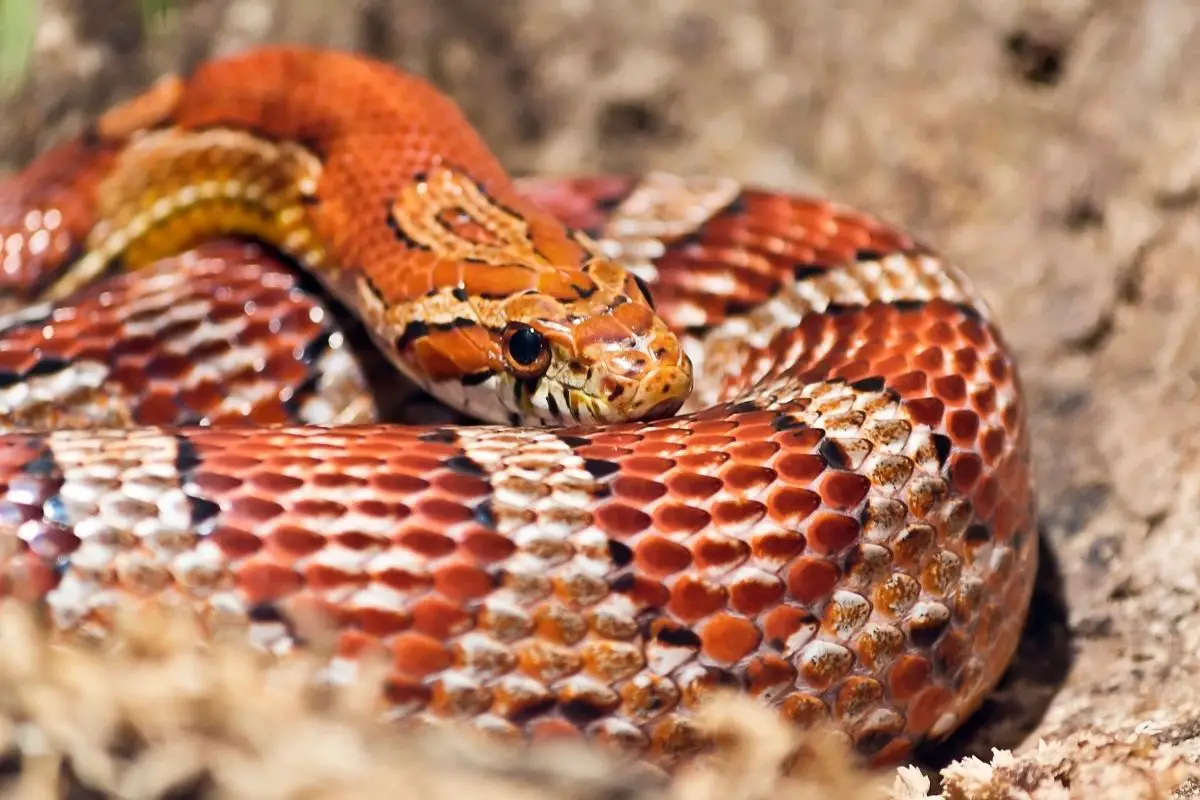Snakes are cold-blooded animals, and like all other reptiles, they depend on their living environment for warmth. That’s why keeping your snake warm using something like a heat lamp is crucial for keeping your pet snake healthy and happy.
But, how warm does it need to be? when do you need to turn on the lamp and when can you turn it off? what happens if you leave the snake alone and the heat lamp must be turned off or it does so unintentionally? Can your snake tolerate the cold?
In simpler words; how cold is too cold for snakes? Lower than 70 degrees Fahrenheit (21 Celcius) is too low for almost all snake species, but the exact temperature mainly depends on the species itself. You need to know the ambient temperature and the basking spot temperature for the species of your snake so you could make their habitat comfortable.
In this article, we are going to discuss exactly what makes a temperature too cold for snakes, the exact requirements of the most popular snake species, what happens if it gets too cold, and answer any other questions you have on your snake’s requirements, so keep reading as I do my best to answer all of this in the simplest way possible.
Contents
How cold is too cold for snakes?

The main reason behind the rise in popularity of snakes as pets in recent years has been mainly due to them being very low-maintenance.
You need very few things to keep them healthy and happy – if we can even say that snakes can be happy.
But temperature is one of those requirements that can be quite difficult to get right if this is your first time owning a snake. Having the right temperature in their tank is crucial for keeping the snake happy, and if it gets too cold for them, they may not even survive.
The temperature at which your snake will get too cold will depend on their species, but as a general rule, most snake species will start to get too cold when the temperature drops below 70 degrees Fahrenheit or 21 degrees Celsius.
Temperature requirements of popular snake species
Below is a table with some of the requirements of the most popular snake species.
| Species | Basking Spot Temperature | Ambient Temperature |
|---|---|---|
| Corn Snake | 85 °F 29.4 °C | 75 °F 23 °C |
| Ball Python | 90 °F 32.3 °C | 80 degrees |
| Boa Constrictor: | 90 °F 32.3 °C | 75 °F 23 °C |
| Hognose Snake: | 88 °F 31.11 °C | 78 °F 25.5 °C |
| California Kingsnake: | 85 °F 29.4 °C | 75 °F 23 °C |
| Rosy Boa: | 85 °F 29.4 °C | 75 °F 23 °C |
| Gopher Snake: | 85 °F 29.4 °C | 75 °F 23 °C |
What do snakes do when it gets too cold?
Snakes will often go into some sort of a dormant state during the winter months to help conserve energy. This means they will not eat or drink and their heart rate will slow down. If it gets too cold outside, snakes may become inactive and even die. So how do they do it?
Brumation

Snakes do not actually hibernate, but instead, they will enter a hibernation-like state that’s called Hibernation, sometimes also referred to as wintering.
During Brumation, the snake will sleep for extended periods of time and their bodily functions will slow dramatically to conserve energy. This ensures the snake survives the harsh winter since it doesn’t expend energy and there is no heat for the reptile to absorb.
Brumation is quite fascinating, and you can learn more about it in this article that discusses if snakes hibernate in houses.
Burrowing
You may also notice a snake burrowing into the earth. Burrowing, even in warm weather, helps keep the snake warm.
The snake will dig into the ground to protect itself from the cold temperatures and elements above ground.
If a snake can’t dig into the earth and burrow itself, it won’t survive the winter.
Huddling

Since your snake is unlikely to be able to burrow itself in its tank, and the temperature in your house probably won’t get so cold that it needs to go into brumation, this is the behavior you’re most likely going to see from your pet snake that will tell you that it’s getting too cold for them.
When the temperature drops, snakes will huddle as well. This might be a solo huddle in which the snake folds up into a ball or a communal huddle with multiple snakes curling up together.
Surprisingly, snakes of various species will usually take part in a group huddle. It goes to show that if the goal is important enough, in this case, it’s preventing heat and energy loss to survive the harsh winter, even snakes, the most solitary creatures that we know of, will work together.
Can Snakes get too cold?
Yes, snakes can get too cold and it’s important to keep an eye on the temperature in your house if you have a snake as a pet.
While they may be able to survive lower temperatures than us, there is still a limit to how cold they can handle before it becomes harmful or even fatal.
If the temperature falls below 40 degrees Fahrenheit or four degrees Celsius, it is too cold for your snake.
Snakes are ectothermic creatures and as such rely on the environment to regulate their body temperature. In colder conditions, snakes will slow down until they reach a point where they cannot move at all because of how cold they’ve gotten.
If you notice your snake is not moving, this could be a sign that the temperature in your home has dropped to an unsafe level for them.
Does the cold weather kill snakes?
Yes, the cold weather can kill snakes if they can’t protect themselves from it in one way or another, for example by going into brumation or huddling together.
Why Snakes bask in the sun

Snakes are cold-blooded reptiles that require the sun and the heat it provides for energy.
If a snake’s body is unable to absorb sunlight through its skin, it will eventually deteriorate. Learn about the numerous advantages of adequate sunshine exposure for snakes:
Getting The Needed Warmth
Snakes require a consistent supply of sunshine and the heat energy it provides to maintain their bodily functions working correctly. Although they can’t spend 24 hours in the sun, enough light and warmth will assist snakes with digestion and metabolism.
Vitamin D
Snakes also generate vitamin D in the same manner as people do, by converting ultraviolet sunlight from the sun.
This vitamin is critical to a snake’s survival since it aids in the maintenance of bones and metabolism.
A single snake has hundreds of bones, which is a testament to how important it is for it to create as much vitamin D as possible.
How to provide a good home for your snake
Snakes are wonderful roommates and rarely expect anything in return. The only thing a snake need is a suitable, temperature-controlled environment. If you’re considering getting a pet snake, here are some simple methods to guarantee that it doesn’t get too chilly.
Install a Thermometer in their habitat
Snakes are most likely to be affected by the cold when they can’t get away from it or if their body is unable to regulate how hot or how cold they are. To ensure that your snake stays protected, you must install a thermometer in its habitat to keep an eye on the temperature inside its enclosure.
A terrarium thermometer is required when setting up your snake’s living space. This will guarantee that the temperature never falls below 65° Fahrenheit (18.3° C), which we now know to be a snake’s freezing point, and that it stays in the 80-90°F range (32° C).
Furthermore, this kind of thermometer will guarantee that the humidity levels are suitable for the snake. The moisture in the air around it will be absorbed by the moist environment, preventing dehydration in the snake.
If you want a Thermometer only, I highly recommend the (very good and still very affordable) VIVOSUN Digital Heat Mat Thermostat from Amazon which you can check here or by clicking on the image below.

However, I would advise getting something better like that Reptizoom Thermometer, Hygrometer, and Temperature controller as it will control everything to make sure the temperature and humidity stay in the most comfortable conditions for your snake.

I used to use only a thermometer in the past, but this device really takes the manual work completely off my plate, so I recommend at least checking it out on Amazon here and giving it a thought.
Consider UVB Lighting
We understand that the sun not only warms snakes but also gives them vitamin D, which is something they won’t get indoors (and you can’t just go around walking your snake in public as you do with a dog), you can get them UVB lighting to emit those rays and simulate the outdoors conditions.
As snakes would in the outside world, they absorb and process ultraviolet radiation, ensuring that their bones and bodily functions remain healthy. Snakes don’t require UVB, but it is said to benefit them in some way, so it’s definitely worth considering.
Provide Ground Cover
Ground cover is necessary for snakes because burrowing is common among them. Hopefully, they will not have to use this method since their terrarium thermometer is functioning correctly. It’s also a good way to cool down and keep themselves safe.
Substrate, a combination of aspen and Cypriot shavings, is often used to line the floor of a snake’s habitat. Snakes love it because of its naturalness and softness to the point that they can tunnel through it.
Conclusion
In conclusion, Snakes get too cold, and it’s important that you take all of the necessary precautions to keep your snake warm. By following these tips, you can be sure that your snake will be happy and healthy.
An inadequate habitat can lead to many problems, including the snake running away even, so you need to make sure everything is just right.
The good news is that even with these specific requirements, snakes take less work to keep in good health than most other pets.
Related Questions
How Cold is too cold for Corn Snakes?
Less than 75 °F or 23 °C is too cold for corn snakes. Try to keep your snake’s tank a bit warmer than that to keep your corn snake happy and healthy. If the temperature drops too low, your snake may suffer some health problems.
If you like this article, please share it!

